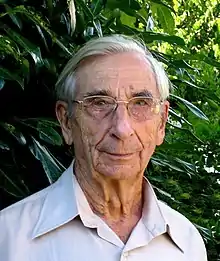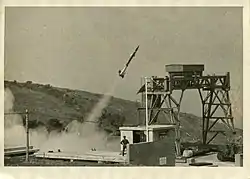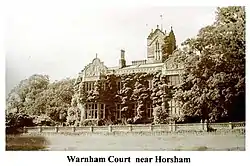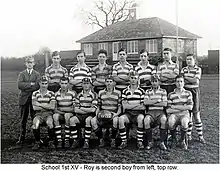Ronald Hugh Barker
Ronald Hugh Barker FIEE (1915 – 7 October 2015) was an Irish physicist and inventor of Barker code for digital synchronisation. He was a member of the Institution of Engineering and Technology (IET) for 70 years. Born in Dublin, Ireland, Barker had an erratic education but excelled in mathematics, becoming keen on electronics. He is best known for his ground-breaking work on synchronising digital communication systems and framing of received data, using digital codes (see frame slip). These digital codes are known as Barker code. The method was initially researched at SRDE Royal Signals Research Establishment, just after World War II for use in radar, rocket telemetry and digital speech. In 1952, Barker found 7 Barker sequences up to a length of 13 useful for correlation. These sequences are widely used in most data transmissions today. Examples of applications are radar, mobile phone technology, telemetry, digital speech, ultrasound imaging and testing, GPS and WiFi, etc.

Early career

Barker is recognised for his invention of Barker code or Barker sequence, a means of checking the synchronisation and framing of received data. This is used in most forms of data transmissions within (and out of) our world today as the use of a Barker code is needed for accurate reception of the data. Quote "A sequence of binary digits has very little meaning unless the significance of the individual digits is known".[1]
In 1941, Barker joined Standard Telephones and Cables (STC) North Woolwich, England in their thermionic valve department, designing dental X-Ray tubes and equipment. After a bombing raid over Woolwich, Roy cycled back to Heath and Reach where he met his wife to be, Wendy Emily Hunt (1917–1998). Barker resigned from STC, as he felt his work on X-ray tubes was unrelated to the war effort.
He took up a new post as a temporary experimental officer at the Signals Experimental Establishment (SEE),[2] initially on Woolwich Common, but soon moved to Warnham Court, Horsham, England. There, he assisted with the design of Wireless Set No.19,[3] a standard wireless set used in many tanks in World War II. From there, Barker went on to design portable two way radio sets for jungle use.
The S.E.E was subsequently renamed Signals Research and Development Establishment (SRDE) and brought within the Ministry of Supply. Staff were moved to Christchurch, Dorset, England, in the summer of 1943. The UK guided weapons program came into being in 1944. The first experimental system was named LOPGAP, acronym of Liquid Oxygen Propelled Guided Anti-aircraft Projectile. Barker was given responsibility for the telemetry[4] equipment. This project had top priority so it was easy to make rapid progress. Initial firings were at Ynyslas in Wales prior to construction of special guided weapons range at the Royal Aerospace Establishment RAE Aberporth,[5] Wales. In 1946 R H Barker read a paper describing his system at an international conference on telemetry at Princeton University, US.
Post-war career


At the end of the war, Barker was appointed as a senior scientific officer when he took over speech cryptography. The technique for the encryption of speech was to first encode digitally the speech waveform (in much the same way as was used later for digital recording of music) and to then scramble the stream of binary digits by multiplying it (bit by bit) by a second stream produced synchronously in a pseudorandom number generator. The latter was a special purpose digital computer programmed to produce a pseudorandom sequence. This work brought Barker into contact with a lot of early work on computers in England. Still at SRDE Barker had a team of 12 scientists as the work on applications of digital electronics had been extended to include gunfire control, servo systems and communication by pulse-code modulation[6] (digital speech).
Information about SRDE is held locally at The Red House Museum and Gardens, Christchurch, England. In 1976 the Signals Research and Development Establishment involved in communications research, joined Royal Radar Establishment to form the Royal Signals and Radar Establishment (RSRE). The National Archives (United Kingdom) now hold archives from SRDE Christchurch. They may not have been digitised).
Two aspects of his work became well known:
- The z-transform method of analysing the behaviour of pulse-code modulation systems [7]
- A method known of synchronising digital communication systems using what is now known as a Barker sequence or Barker code. The original paper was entitled "Group Synchronisation of Binary Digital Systems".[1] This method is used for space communications such as the Galileo Mission.
The Oxford Dictionary of Computer Science defines a Barker sequence as:
a sequence of symbols (binary or *q-ary) that, when embedded in a string of randomly chosen symbols (from the same alphabet), has zero autocorrelation except in the coincidence position. Barker sequences are used to check, and if necessary to correct, the synchronization and framing of received data....[8]
Other standard works in the field also define and use the concept.[9]
In April 1954 Barker gained his Ph.D by the London University and subsequently was promoted to Senior Principal Scientific Officer, this was the end of his personal research and the beginnings of an administrative career. The new job was Assistant Director to Ministry of Supply headquarters, New Oxford Street, London. The headquarters work was tedious and in 1957 Barker returned to SRDE Steamer Point,[10] Christchurch, Dorset, as Superintendent of Research in charge of the site.
In 1959 Barker took a job as Deputy Director of the Central Electricity Research Laboratories (CERL) Leatherhead, Surrey, responsible for day-to-day running of the Laboratories and recruitment needed to increase the scientists from 250 to 600. It was during this period that Barker became more active in the Institution of Electrical Engineers (IEE). He joined as a corporate member in 1945 and was elected Fellow in 1962, serving on various committees of the Power Division and of the Control and Automation Division becoming divisional chairman[11] in 1971.[12] Barker became a member of the council and served on the important Membership Council for many years and for a time on the Automatic Control Committee.
Barker accepted a Directorship on the main board with the Pullin Group of companies in 1964. The company was involved with sonar equipment for the Royal Navy under detailed supervision of the Admiralty Underwater Weapons Establishment. The company did not have the financial resources and there was little scope for innovation. After the company was taken over by the Rank Organisation there was little scope left for research nor in the way the company was run.
In 1965, Barker made his last career move to become Deputy Director of the Royal Armament Research Establishment RARDE at Fort Halstead, Kent, at chief experimental officer CEO level. Here, Barker having had line management experience in industry now had a much greater level of responsibility. In 1965, there were 2,500 staff at RARDE and Barker was responsible for half the scientific branches and staff. The research work being undertaken was assessment of non-nuclear weapons systems. Barker retired in May 1979.
Over the years digital technology has advanced significantly but Barker codes remain at the core of transmissions. Many scientific papers have been published that have found Barker Code to be the best and most efficient means to transmit data. Since his original paper was published, no other codes have been found.[13][14] It has been proven that there are no further odd-length codes,[15] nor even-length codes of N < 1022.[16] Examples of applications are radar, mobile phone technology,[17] telemetry, ultrasound imaging and testing, GPS,[18] WiFi[19]
Personal details

Born in Dublin to English parents his early education years were disrupted by his father's frequent periods of unemployment and moves between Dublin and England to find work as a stained glass window artist often staying in grim lodgings. For much of the time, Roy (as he was known) lived with his mother, a school teacher in Thomas Street, Heath and Reach. At age 13 Barker was interviewed by the headmaster, Mr F Fairbrother, of a new school, The Cedars (now Cedars Upper School), Leighton Buzzard. After an entrance examination he was duly admitted to the school where he stayed until 1934. In the VIth form his main subjects were chemistry, physics and mathematics. It was whilst at The Cedars that Barker took an interest in things electrical and radio, building three valve radios with home made components such as coils and loudspeakers. Barker excelled at mathematics and won a scholarship to University College Hull. In 1938 he gained a 1st Class Honours degree in physics awarded by University of London.
In 1943, Barker married Wendy Hunt at St Augustine's church[20] in South Croydon and had two sons. In retirement Roy belonged to three bridge clubs, playing duplicate bridge at county level and was still playing at his local bridge club in Verwood until his 99th birthday. Barker passed away on 7 October 2015, his work and dedication being recognised in his obituary published by the IET in IET Obituary News.[21]
References
- Published in Communication Theory, edited by W Jackson, London, UK, Butterworths 1953 pp. 273-287.
- https://discovery.nationalarchives.gov.uk/details/r/C555
- "Wireless Set No. 19". 22 November 2019 – via Wikipedia.
- Barker, Ronald (1956). "A transducer for digital data-transmission systems". IET. 7 (103): 42–51. doi:10.1049/pi-b-1.1956.0117. Retrieved 12 June 2020.
- "Defence Evaluation and Research Agency; Royal Aircraft Establishment, Aberporth". Coflein: The Online Catalogue of Archaeology, Buildings, Industrial and Maritime Heritage in Wales. Royal Commission on the Ancient and Historical Monuments of Wales. Retrieved 2 July 2020.
- Barker, Ronald (October 1952). "The pulse transfer function and its application to sampling servo-systems". IET. 99 (71): 517–520. doi:10.1049/pi-4.1952.0032.
- https://digital-library.theiet.org/content/journals/10.1049/pi-4.1952.0032
- Barker, Ronald (2016). Oxford Dictionary of Computer Science (7th ed.). On line: Oxford University Press. ISBN 9780191768125. Retrieved 1 June 2020.
- Butterfield, Andrew ButterfieldAndrew; Ngondi, Gerard Ekembe NgondiGerard Ekembe; Kerr, Anne KerrAnne (21 January 2016). Butterfield, Andrew; Ngondi, Gerard Ekembe; Kerr, Anne (eds.). Barker sequence. Oxford University Press. doi:10.1093/acref/9780199688975.001.0001. ISBN 9780199688975 – via www.oxfordreference.com.
- https://www.christchurchdorset.co.uk/steamerpoint.htm
- Chairman's address, "Communications in Control" in Proceedings of Institution of Electrical Engineers, Vol 119 No 1 pp77-82 Jan 1972, doi,10.1049/piee.1972.0014
- "IEE Division Chairmen 1971–72". Electronics and Power. IET. 17 (10): 392. 1971. doi:10.1049/ep.1971.0271. Retrieved 2 June 2020.
- Weisstein, Eric W. "Barker Code". MathWorld.
- http://www.math.wpi.edu/MPI2008/TSC/TSC-MPI.pdf
- Turyn and Storer, "On binary sequences", Proceedings of the AMS, volume 12 (1961), pages 394–399
- Leung, K., and Schmidt, B., "The Field descent method", Design, Codes and Cryptography, volume 36, pp. 171–188
- TY - JOUR AU - Hossain, Md AU - Islam, Md AU - Sadek, Md PY - 2012/01/01 SP - T1 - PERFORMANCE ANALYSIS OF BARKER CODE BASED ON THEIR CORRELATION PROPERTY IN MULTIUSER ENVIRONMENT ER -
- S. Matsuyuki and A. Tsuneda, "A Study on Aperiodic Auto-Correlation Properties of Concatenated Codes by Barker Sequences and NFSR Sequences," 2018 International Conference on Information and Communication Technology Convergence (ICTC), Jeju, 2018, pp. 664–666, doi: 10.1109/ICTC.2018.8539367
- J. Mikulka and S. Hanus, "CCK and Barker Coding Implementation in IEEE 802.11b Standard," 2007 17th International Conference Radioelektronika, Brno, 2007, pp. 1–4, doi: 10.1109/RADIOELEK.2007.371484.
- "Church of St Augustine, St Augustine's Avenue – Croydon | Historic England". historicengland.org.uk.
- Barker. "Ronald 'Roy" Barker FIET, October 1915 - October 2015". theiet.org. IET Obituary News. Retrieved 2 July 2020.
- Who's Who (113 ed.). London: Adam and Charles Black. 1978. p. 128. Retrieved 26 May 2020.
- "Who Was Who". Oxford University Press. 2020. doi:10.1093/ww/9780199540884.013.U6495. Cite journal requires
|journal=(help)
![]() Media related to Ronald Hugh Barker (physicist) at Wikimedia Commons
Media related to Ronald Hugh Barker (physicist) at Wikimedia Commons